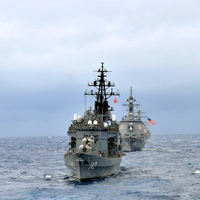When, upon being elected, Japan's Prime Minister Yukio Hatoyama spoke of building fraternal seas and constructing a European Union-styled East Asian Community, critics denounced him as a naive peacenik. But Hatoyama's low-profile Nov. 23 decision to commission a new DDH-22 helicopter destroyer -- Japan's largest military vessel since World War II -- suggests he is actually striking a shrewd balance between promoting regionalism and protecting Japan's regional and global interests through robust naval capabilities.
The DDH-22 is officially designated as a "helicopter-carrying destroyer" by Japan's Maritime Self Defense Forces (MSDF). But with its flush flight deck and large, starboard-side island structure, it looks a lot like a "light" aircraft carrier. While Japanese law states that carriers "exceed the war potential needed for a minimal level of self-defense" permitted by Japan's pacifistic post-war constitution, the MSDF has craved such capabilities since the 1960s, and Tokyo has long been inching closer and closer to this goal. Hatoyama's decision to commission the DDH-22 culminates a request first made when the opposition Liberal Democratic Party (LDP) was in power, suggesting that a bipartisan consensus exists for the expansion of Japan's naval power.
While defense officials are loathe to say so publicly, the move is at least partly directed at China. Though Japan is still the Pacific's second-largest naval power (after the United States), Beijing's blistering military buildup is threatening to blunt Tokyo's superiority at sea. Earlier this year, China's People's Liberation Army Navy flexed its military muscle by deploying cruise-missile-laden destroyers around energy-rich gas fields in the East China Sea, and by conducting training exercises in the disputed Senkaku Islands.

